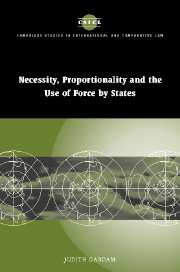Book contents
- Frontmatter
- Contents
- Foreword
- Preface
- Acknowledgments
- Table of cases
- List of abbreviations
- 1 The place of necessity and proportionality in restraints on the forceful actions of States
- 2 Necessity, proportionality and the forceful actions of States prior to the adoption of the United Nations Charter in 1945
- 3 Proportionality and combatants in modern international humanitarian law
- 4 Proportionality and civilians in modern international humanitarian law
- 5 Necessity, proportionality and the unilateral use of force in the era of the United Nations Charter
- 6 Necessity, proportionality and the United Nations system: collective actions involving the use of force
- Bibliography
- Index
- Cambridge Studies in International and Comparative Law
Preface
Published online by Cambridge University Press: 16 July 2009
- Frontmatter
- Contents
- Foreword
- Preface
- Acknowledgments
- Table of cases
- List of abbreviations
- 1 The place of necessity and proportionality in restraints on the forceful actions of States
- 2 Necessity, proportionality and the forceful actions of States prior to the adoption of the United Nations Charter in 1945
- 3 Proportionality and combatants in modern international humanitarian law
- 4 Proportionality and civilians in modern international humanitarian law
- 5 Necessity, proportionality and the unilateral use of force in the era of the United Nations Charter
- 6 Necessity, proportionality and the United Nations system: collective actions involving the use of force
- Bibliography
- Index
- Cambridge Studies in International and Comparative Law
Summary
Proportionality is a familiar idea and is designed to ensure that the ends justify the means. Its requirements are reflected today in several diverse areas of international law. The focus of this work is the operation of proportionality as a restraint on the forceful actions of States. The concept is incorporated in the norms that govern the use of force in international relations (ius ad bellum) and those that regulate the conduct of hostilities (ius in bello or international humanitarian law (IHL)). Necessity is also a familiar idea and in common with proportionality finds various expressions in international law. It is considered here for its role in determining whether a forceful response is warranted in any particular situation.
The general structure of the work is as follows. First, I assess the development and current content of proportionality in the twin international law regimes of ius in bello and ius ad bellum. Secondly, I undertake the same task in relation to necessity but only as a component of ius ad bellum. In my view necessity has no detailed form in ius in bello and is not covered in any depth in this work. The title of the work, therefore, may initially be somewhat misleading in that a great deal more of the work is devoted to a consideration of proportionality than to necessity.
The somewhat disjointed development of the legal framework in which proportionality has operated over the years has significantly dictated the structure of this work.
- Type
- Chapter
- Information
- Necessity, Proportionality and the Use of Force by States , pp. xv - xviiiPublisher: Cambridge University PressPrint publication year: 2004

